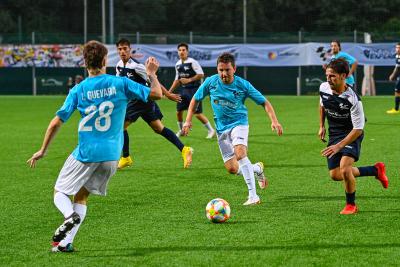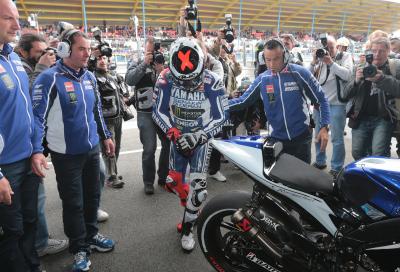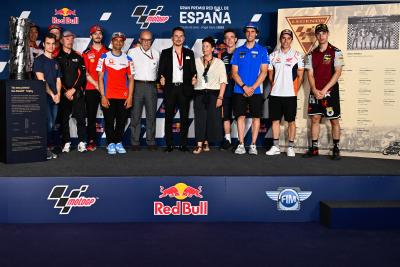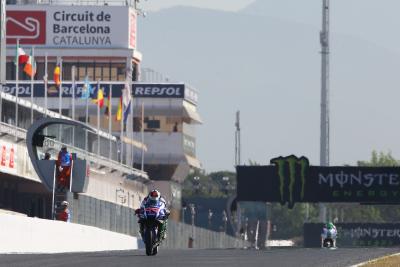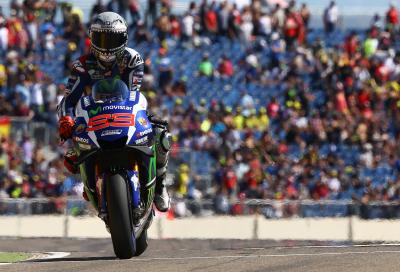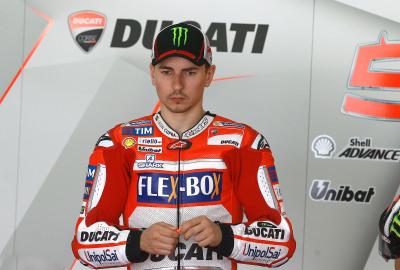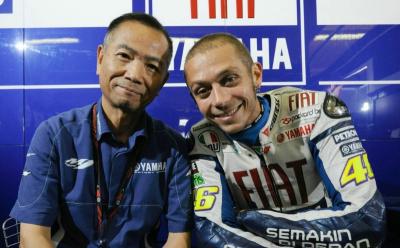Jorge Lorenzo
Personal Information

About Jorge Lorenzo
Jorge Lorenzo was born on the Balearic island of Mallorca, Spain on 4th May 1987. He began riding motorbikes at home at the tender age of three and within months of taking to two wheels was competing in his first minicross races.
Career Stats
Latest News
Full Biography
Jorge Lorenzo was born on the Balearic island of Mallorca, Spain on 4th May 1987. He began riding motorbikes at home at the tender age of three and within months of taking to two wheels was competing in his first minicross races. In 1995, aged eight, he won the Balearic title and followed that up the following year by taking the Island’s minicross, trial, minimoto and junior motocross titles.
Lorenzo graduated to road racing and national competition in 1997 and it didn’t take him long to adjust, winning the Aprilia 50cc Cup in 1998. Despite officially being too young, a special dispensation in 2000 allowed him to compete in the Spanish 125cc series at the age of 13 and he made history the following year when competing in Europe and becoming the youngest ever winner of a European 125cc race.
The precocious teenager, once again showing that age was no limit to a quick rise up the ranks of motorbike racing, made his first foray onto the world stage with Derbi at the Spanish Grand Prix in Jerez in 2002, the third round of the season. He did not reach the legal age of 15 until Saturday and therefore missed the first day of practice but was unfazed this and impressed the paddock by qualifying for the race, cementing his position in the World Championship over the course of the season as he got to grips with the circuits.
The young Mallorcan hit the big time the following season, winning his first 125cc Grand Prix in Rio de Janeiro and then going on to win three more races the following season, finishing fourth in 2004 and taking his podium tally to nine before making the step up the quarter-litre class and switching to Honda machinery. Six podium finishes and four pole positions in his rookie 250cc season sealed fifth in the championship and, with a move to the Aprilia factory team, 2006 was widely expected to be his defining year.
Lorenzo indeed surpassed all expectations in 2006, dominating the class with eight wins and a record-equalling ten poles, clinching his first world title convincingly. 2007 saw more of the same and an incredible nine pole positions saw him win from every single one of them, claiming his second world title at the penultimate round in Sepang. He also became the most successful 250cc Spanish rider of all time in the process.
He joined Yamaha in 2008 and exploded onto the MotoGP scene with an outstanding pole position at the opening round in Qatar, before finishing second in the race. A second pole position and another podium in round two proved it was no fluke, before he went on to take an incredible third pole and a deserved maiden win at the third race in Estoril. He returned to earth with a bump in China, when a crash in practice saw him fracture both ankles, although he battled on to finish fourth in the race before coming back with another podium next time around in France. The middle part of the season was difficult for the young Spaniard as several more crashes left him with further injuries and battered confidence, but he never gave up and made it back to claim two more podiums. He finished the season in fourth position as rookie of the year, the most successful debutante since the start of the four-stroke era.
Following his outstanding debut year, Lorenzo came of age in 2009, winning four races and pushing his team-mate Valentino Rossi to the limit throughout a superb season. The Spaniard took the team’s first victory of the year at Yamaha’s home race in Japan and he went on to take further wins at Le Mans, Indianapolis and, for the second year in a row, Portugal .
Lorenzo and his team-mate Rossi produced some of the greatest racing in years as they fought wheel to wheel at race after race, with the last-lap battle in Barcelona standing out, amongst others. Although Lorenzo lost out there by a few thousandths of a second, the performance he put up against his older and more experienced team-mate was enough to convince even the most sceptical of onlookers that he is a champion of the future.
As well as his four wins, Lorenzo stood on the podium an additional nine times and only missed out once in all 17 rounds on a front-row qualification, a remarkable show of consistency. He was Rossi’s only championship challenger in the latter half of the season and once that chance was gone he focused on securing the number two spot, which he duly did in Valencia.
Having run Rossi close in 2009, Lorenzo came into the 2010 season looking to beat his adversary under equal terms, though a pre-season injury certainly cast doubt on whether he could mount a challenge from the start. As it happens, the Spaniard signalled his intentions with two wins during the opening three races, earning him the early edge over Rossi.
In the end, Rossi’s leg injury during the fourth round scuppered any chance of a season-long rivalry, but with Lorenzo proceeding to win nine races on the way to a dominant title victory, many feel he would have been difficult to beat regardless.
Indeed, with a record-breaking points’ total to his name and 16 podiums in 18 races, Lorenzo shrugged off the inconsistency reputation that dogged him initially and naturally assumed Rossi’s mantle as team leader when the Italian defected to Ducati.
With ‘No.1’ adorned on his Yamaha, Lorenzo set about defending his title, though pre-season testing had revealed the M1 to be down on the pace of the four factory-specification Honda RC212Vs of Stoner, Pedrosa, Dovizioso and Simoncelli.
Indeed, once racing was underway, the Honda proved the bike to beat from the off, but Lorenzo’s race craft was enough to make his Yamaha a race-win contender, while his consistency served to keep Stoner honest for much of the year.
Wins at Jerez, Mugello and Misano kept him in the hunt, though an injury sustained at Phillip Island would force him out of action for the final three rounds. Even so, Lorenzo was still able to seal the runners-up spot for the second time in three years.
With the much discussed return to 1000cc machinery expected to pose a new challenge for both Lorenzo and Yamaha, the Spaniard went into the off-season keen to prove that Stoner’s 2011 success was not indicative of an era of dominance.
And so it proved, Yamaha coming up with a bike that would prove marginally quicker than Honda’s machine particularly on race tyres -, allowing Lorenzo to notch up four wins in the opening six races. Opening up a small gap over Stoner and Pedrosa, though a controversial crash at Assen blamed on an errant Alvaro Bautista pegged him back, Lorenzo remained a model of consistency throughout the year.
When Stoner eliminated himself from the running through injury, Lorenzo would spend the second-half of the year contending with a charging Pedrosa instead. However, with an even healthier margin over the Spaniard in hand, a canny Lorenzo would simply spend the latter half focusing on second place behind his countryman knowing it would be enough to keep him ahead overall.
Going on to seal a second career title with one round to spare, what Lorenzo’s year lacked in headlines at least compared with Pedrosa, Stoner and even Rossi -, he made up for with consistency and a blistering turn of pace when he needed it.
Often overshadowed in the 2013 pre-season media spotlight by rookie Marc Marquez and returning team-mate Rossi, Lorenzo let his riding do the talking as he sought to claim back-to-back titles for Yamaha.
Three wins from the opening six races elevated Lorenzo to the status of title favourite, but consecutive collarbone injuries at Assen and Sachsenring left him facing an uphill battle.
For bravery and determination alone, Lorenzo’s performance at Assen - finishing fifth just two days after surgery - was incredible.
A cut above his fellow Yamaha riders, Lorenzo’s valiant attempt to close down Marquez saw him provide the only real opposition to the Repsol Honda riders in the second half of the season.
Renowned for his speed and smoothness, Lorenzo - frustrated that Race Direction had not taken a tougher line with Marquez - responded by unleashing his street-fighting side during some physical end-of-season battles.
Lorenzo was ultimately left just four points shy of Marquez, but 93 points ahead of his team-mate Rossi, despite missing the German GP. Lorenzo also scored the most race wins of the year (eight), even though his M1 could only provide two fastest race laps.
2014 would be very much a season of two halves for Lorenzo, who took just three podiums during the opening nine rounds - then outscored all other riders during the final nine events.
Expected to again lead the Marquez opposition, Lorenzo was instead blindsided by tyre and fitness issues during the winter. The usually composed Spaniard was still unsettled when the racing began - falling while leading the opening lap in Qatar, making a bizarre jump-start in Texas and admitting to being scared by the damp conditions at Assen.
While Lorenzo floundered, Marquez ran away with the wins and Rossi became the darling of Yamaha with his return to form. If Lorenzo had been offered third in the standings, within touching distance of the runners-up spot, at the half-way stage of the season he’d surely have snatched it.
But the Spaniard returned a different man after the summer break, finishing no lower than second for seven races in a row, including back-to-back wins at Aragon and Motegi.
Trying to overhaul Rossi for second in standings at the Valencia finale, Lorenzo gambled on the rain increasing and made a pit stop for his wet bike. His timing had been perfect at Aragon, but backfired on this occasion, leaving him with his only non-finish of the second half of the season.
Nevertheless, Lorenzo scored 166 points during the last nine rounds, compared with 154 points for Rossi and 137 for Marquez.
2015 saw Lorenzo win his third MotoGP title after a down-to-the-wire battle with Rossi, but the season was marred by end-of-season controversy.
Faster than title rival Rossi, and therefore a deserving champion, Lorenzo led every lap on the way to his seven race wins this year, qualifying off the front row just once in the last nine rounds and setting the fastest lap in five of the final six GPs.
But while Lorenzo may be MotoGP's Mr Smooth, rarely getting his M1 out of shape, he wasn’t as consistent as his team-mate - a helmet problem in Qatar being followed by sickness in Austin and tyre issues in Argentina, meaning he didn’t claim a podium until victory at Jerez.
Thereafter, wet or especially mixed conditions proved his only Achilles’ heel, most notably a DNF at Misano, the only non-finish of the year for either Movistar Yamaha. All of which meant, barring a brief spell tied on points with Rossi following Brno, Lorenzo spent the entire season trying to chase down the #46.
While his dry race performances were flawless, some of Lorenzo’s late season behaviour alienated fans.
The first incident was when, instead of keeping the Rossi-Marquez controversy at arm’s reach after the Sepang race - and perhaps basking quietly in how massively Rossi’s decision to publicly attack Marquez had backfired - Lorenzo gave a thumbs down gesture on the podium and walked off before the champagne celebrations.
He then waded straight into the issue of whether Rossi had received an adequate punishment, making clear he wanted a stronger punishment and that the Italian was being given special treatment. The #99 would later apologise for his conduct on the podium.
The next occurred shortly after winning the race and title at Valencia, when in the heat of the moment Lorenzo told the Movistar TV channel that countrymen Marquez and Pedrosa “helped me because for sure in another kind of race they would have tried to overtake”.
Lorenzo may have added that Italian riders would have done the same for Rossi, but given the uproar after Sepang it was the last thing Marquez and Pedrosa wanted to hear and only fuelled those eager to label the title outcome as unfair.
It was also wrong. Lorenzo had made the comment before watching the race and, even those who agree with Rossi’s claim that Marquez wanted to assist Lorenzo, would admit that Pedrosa’s late charge to catch the pair (and briefly pass Marquez) had nothing to do with trying to keep the title in Spain.
Lorenzo backtracked after hearing Marquez and Pedrosa explain what had happened, adding that he 'could not see the race from the outside', but the damage was done.
Still, having spent much of the season being booed by ‘fans’ at racetracks around the world, largely because he was Rossi’s main rival, perhaps Lorenzo earned the right to make a few such indiscretions.
Either way, he has the honour of being Spain's first ever triple premier-class champion to help console him.
When reigning champion Jorge Lorenzo dominated the opening 2016 test at Sepang, then won the first race of the new Michelin era in Qatar, he looked in with an excellent chance of winning a fourth premier-class title. Despite a DNF in Argentina, the silky-smooth Spaniard went on to finish the first third of the season with a ten-point advantage over Marc Marquez (and 37-point advantage over team-mate Valentino Rossi) - highlighted by a thrilling victory over the Honda rider in Mugello.
But by the time MotoGP headed for its mid-season break just three rounds later, Lorenzo had been rammed by Andrea Iannone in Catalunya, then seen his lack of confidence in the wet Michelin front tyre mercilessly exposed in Assen and Germany. Lorenzo lost 58 points to Marquez in the space of those three races and, with hindsight, his title challenge was over.
Although Lorenzo returned to the podium during the second half of the season, his results were hit and miss - the outcome reflecting his varying confidence in the front tyre. The #99 wouldn't win again until his Yamaha farewell at Valencia, by which time it was too late to prevent Rossi surpassing him as title runner-up.
It's worth remembering that Rossi didn’t win at all during the second season half of the season - the likes of Honda, Ducati and Suzuki gaining ground on the M1, a bike which had won five of the opening seven races.
After spending all nine of his premier-class seasons at Yamaha, Lorenzo is starting a new chapter in his career at Ducati in 2017, where the 44-time MotoGP race winner will attempt to claim the Italian factory's first title since 2007.
Latest Photos
